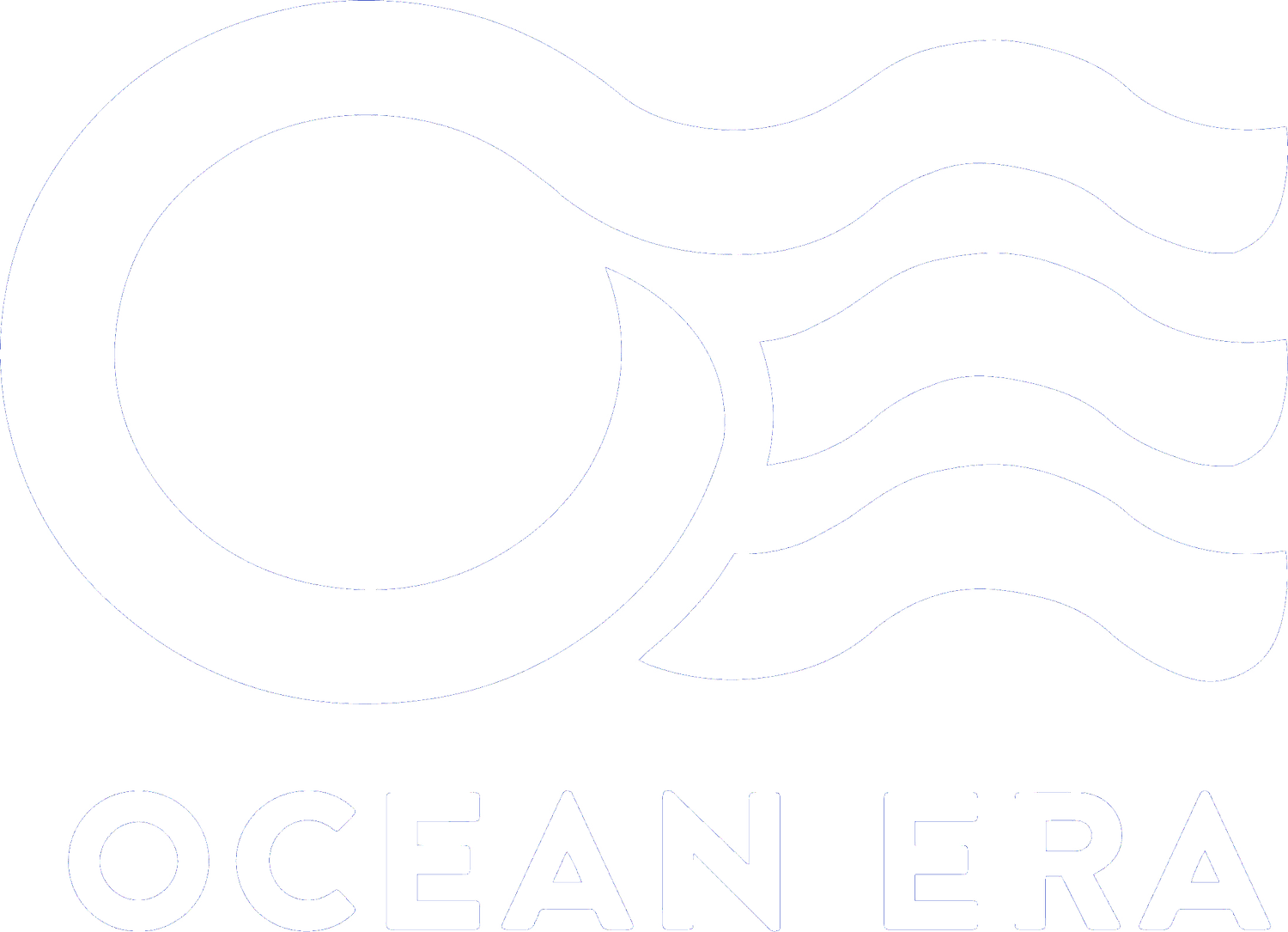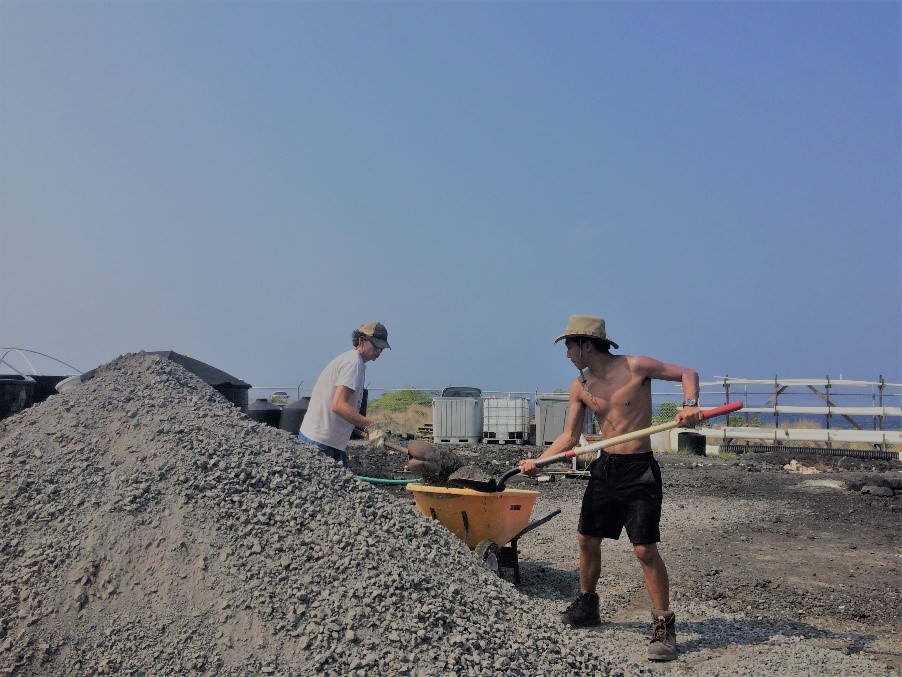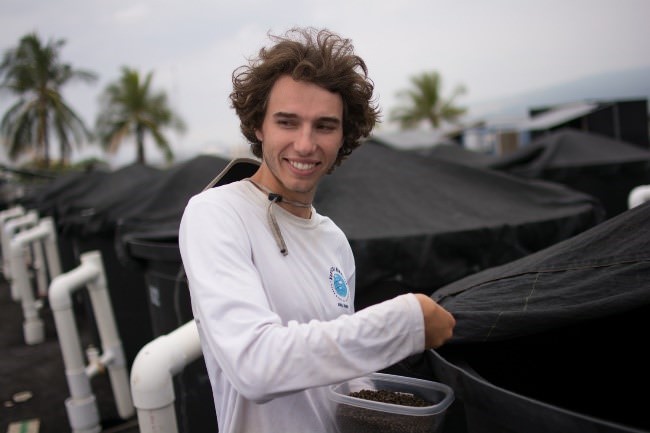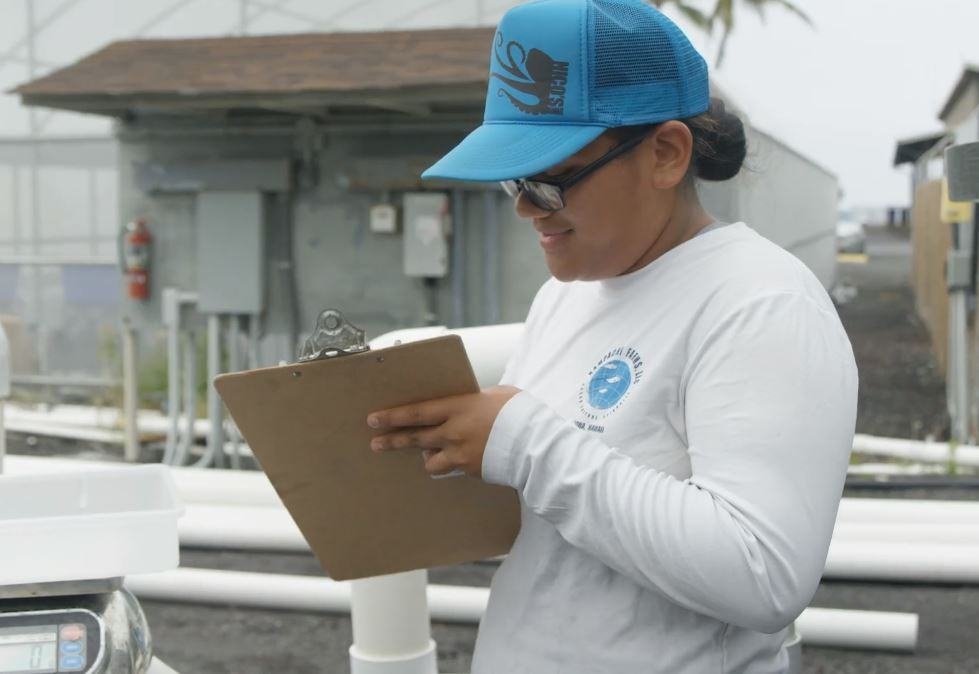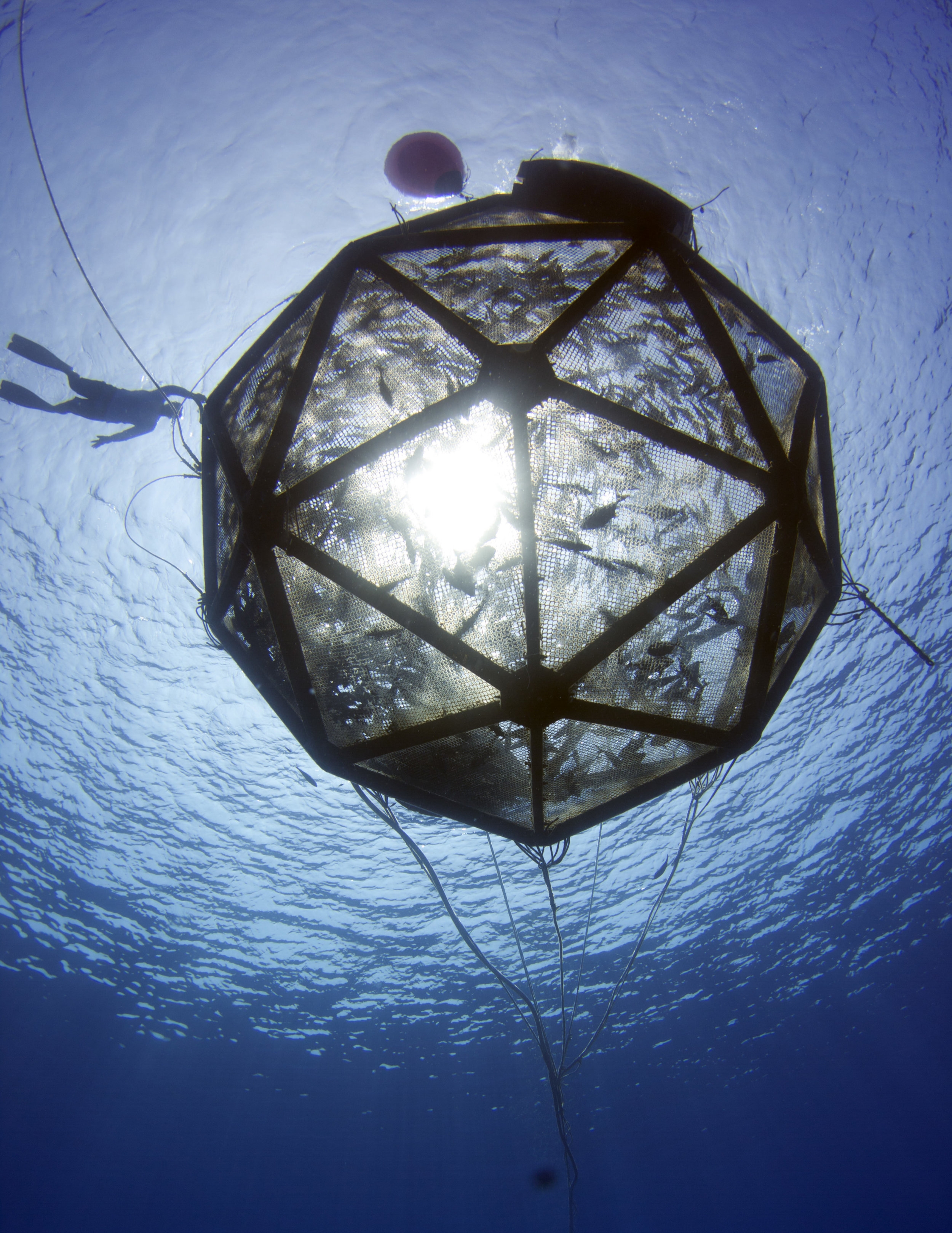Hooked on Aquaculture: Interview with Kampachi Farms’ Interns
From left to right: Travis Burroughs (intern), Julien Stevens (internship coordinator), and C.J. Chao (intern).
As the Internship coordinator at Kampachi Farms, I regularly field emails and calls from marine scientists in training, and aspiring fish farmers. I myself started out at Kampachi Farms as an intern, and I’m a firm believer in the opportunities that volunteering can provide. It’s a great way to gain aquaculture experience, and to get to know an organization without having to commit yourself for the long term. But often potential aquaculture interns have a romanticized notion about what their role might be. To clarify what the role is all about I’ve asked our two summer interns, C.J. and Travis, to answer a few questions.
Can you tell us a bit about yourself and why you wanted to intern at Kampachi Farms?
C.J. Chao: I’m a senior at Boston University studying Environmental Policy and Analysis. I came to Kampachi Farms because of my great interest in aquaculture, which stems from my love of the ocean. I look at aquaculture as a possible sustainable substitute for depleting wild fisheries and want to be involved in an industry that is new, progressive and exciting. I’m originally from San Francisco but grew up in the suburb of Marin. I’m a certified master scuba diver and also maintained saltwater aquariums as a kid. These two hobbies fostered my interest in the aquaculture field.
Travis Burroughs: I’m from Larkspur, California, and am a senior at the University of Denver studying sustainability and marketing. My interest in aquaculture was sparked by my lifetime of fishing, which first led me to an internship at Monterey Abalone Company last summer. I had a fantastic experience there and with my love of fish, I wanted to gain work experience with a company that focuses on environmentally responsible fish farming.
What sort of work did you do during your internship at Kampachi Farms?
Travis: The internship was both full of routine experience and novel challenges, depending on research needs. These routine tasks included: feeding fish, observing behavior, scrubbing tanks, maintaining the filter systems through back flushing and cleaning filters, and tidying up the site. We also helped to move 20 tons of gravel to level the site for new broodstock tanks for our kampachi.
CJ: Each day Travis and I would complete necessary husbandry tasks, including feeding fish and cleaning tanks. We also assisted with ongoing experiments, including a feed trial using an experimental soy-based feed, and testing the viability of growing algae in the open ocean for human, animal feed, and biofuel purposes.
What did you learn from your internship?
CJ: Kampachi Farm’s research team offered me a wide ranging and in-depth look into research-oriented aquaculture. During my internship I was able to work with many farmable marine species, including Seriola rivoliana (also known as Kampachi or Yellowtail Amberjack), Giant Pacific Grouper, Nenue (Grey Chub) and several species of algae.
Travis: While at the Kampachi Farms R&D facility in Kona we were given a first-hand look into fish husbandry at the different life stages. We were lucky enough to be on site during a feed trial, where over 700 fingerling kampachi that had been spawned and hatched out on site, were being grown out on different sustainable feed options. We began feed trials with fish ranging in size from 14-40 grams, which involved weighing, measuring, and tagging each individual fish and then putting them into marked tanks. The goal of the feed trial was to compare different feeds and see which one produced the best FCR and overall fish health. The data collected on-site could then be used in future commercial use with Kampachi Farm’s King Kampachi in La Paz Mexico.
Some of the Kampachi Farms research team with C.J. and Travis on their last day.
A few considerations to keep in mind for potential interns: All of our research work in Kona is grant-funded, and so we are presently unable to pay interns for their time. Any internship would therefore need to be on a pro-bono basis. Feel free to get creative in your self-funding options; we have had students find outside funding from their University or regional STEM internship programs. Interns are required to provide their own housing and transport to Kona, and must also have reliable ground transportation when here on the island (public transport in Kona is virtually non-existent).
We love hosting passionate aquaculture interns when our research schedule allows it. If you are interested, please contact our team to learn more about our internship program. You can also stay up to date with our current research projects here.
Seaweed to the Rescue: Foods, Feeds, and Fuel
Macroalgae, or seaweeds, have been around for a very, very long time; fossil evidence of a red macroalga has been dated between 1 and 1.6 billion years ago (1). Seaweeds must be doing well for themselves, if they’ve survived this long! It’s this realization that has catalyzed phycological research ranging from nutrition, skin care, pharmaceuticals, and more recently, in aquaculture, alternative fuel sources, and carbon sequestration strategies (2-6). Seaweed is even being experimented with as an alternative to plastic packaging (7). Macroalgae have been overlooked by most of the world for far too long, but all of this is now changing, and rapidly. Although seaweed is not a new research topic, significant efforts and investments are being made to further explore its potential.
Before all of this, though, seaweed has been a consistent source of food. The farming of macroalgae is thought to have originated in Japan between the 17th and 19th centuries (8); harnessing the value of seaweed mariculture with no need for using arable land, freshwater, or artificial nutrients, all while introducing a way to help absorb excess nutrients or carbon from the ocean.
Seaweed farming at Nusa Lembongan, Bali. © Jean-Marie Hullot
Macroalgae mariculture is a huge commercial operation in Southeast Asian countries like Japan, China, Korea, and the Philippines. The west is slowly catching on. In Hawaiʻi, seaweed has been utilized for hundreds of years. We have over 500 species of seaweeds here in the islands, and our edible macroalgae, or limu, are savored in local cuisine. As the most remote archipelago in the world, there is a lot of ocean to go around—and this ocean is deep. On the west side of the Big Island (Hawaiʻi Island), the water depth plummets to 6,000 ft. (1,829 m), a mere three miles (4.8 km) offshore. West Hawaiʻi’s Natural Energy Lab of Hawaiʻi Authority (NELHA) supplies a consistent source of seawater pumped from two locations: surface seawater (SSW) from 69 ft. (21 m) and deep sea water (DSW) from 2,211 ft. (674 m). With a broad selection of native algal species, access to NELHA’s DSW and SSW on tap, Hawaiʻi is an ideal location to research mariculture opportunities. Our Blue Fields Project is designed to do just that. Funded by the Department of Energy’s MARINER Program (Macroalgae Research Inspiring Novel Energy Resources), the Blue Fields project proposes to test a single-point mooring array for high-yield macroalgae culture (9).
The two major challenges for offshore macroalgae culture in Hawaiʻi are species selection and offshore nutrient delivery. Very little research has been done into the culture of Hawaiʻi’s native species, and as a result there is limited knowledge of their growth requirements. There are demonstrable (and demonstrated) risks with introducing non-native algal species, which may compete with native ones (10). We will therefore only be using native species in our growth trials. Tropical surface waters are also nutrient poor, which explains their clear blue color. However, Hawaiʻi’s bathymetry (the steep offshore slope of the islands) means that nutrient rich DSW is readily available, and we plan on testing this as a means to stimulate macroalgae growth.
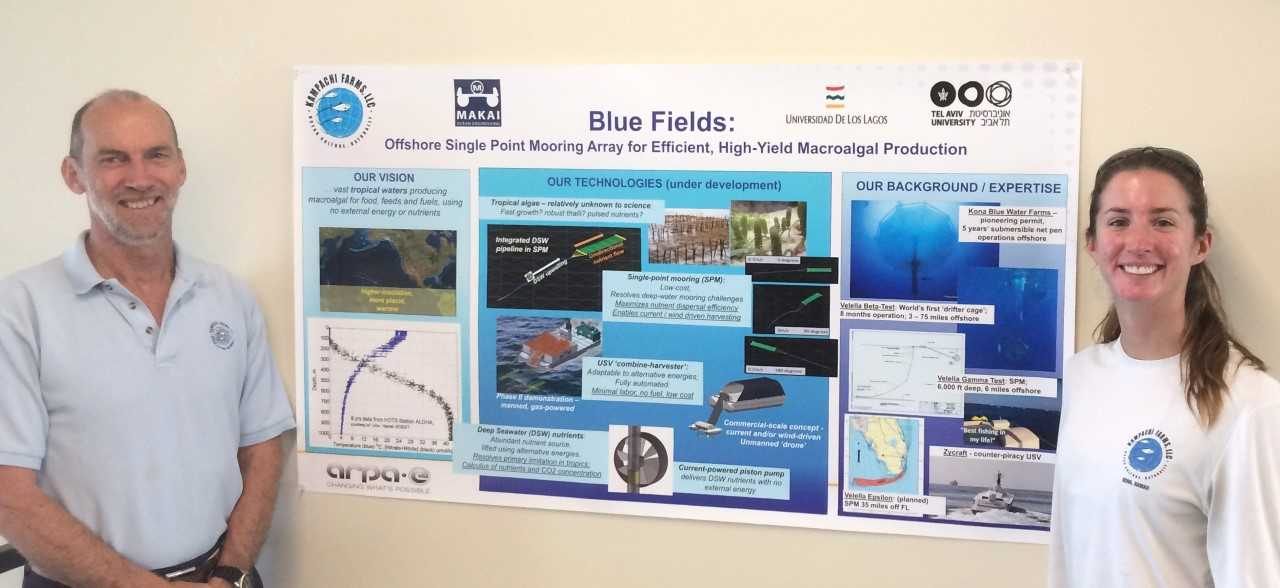

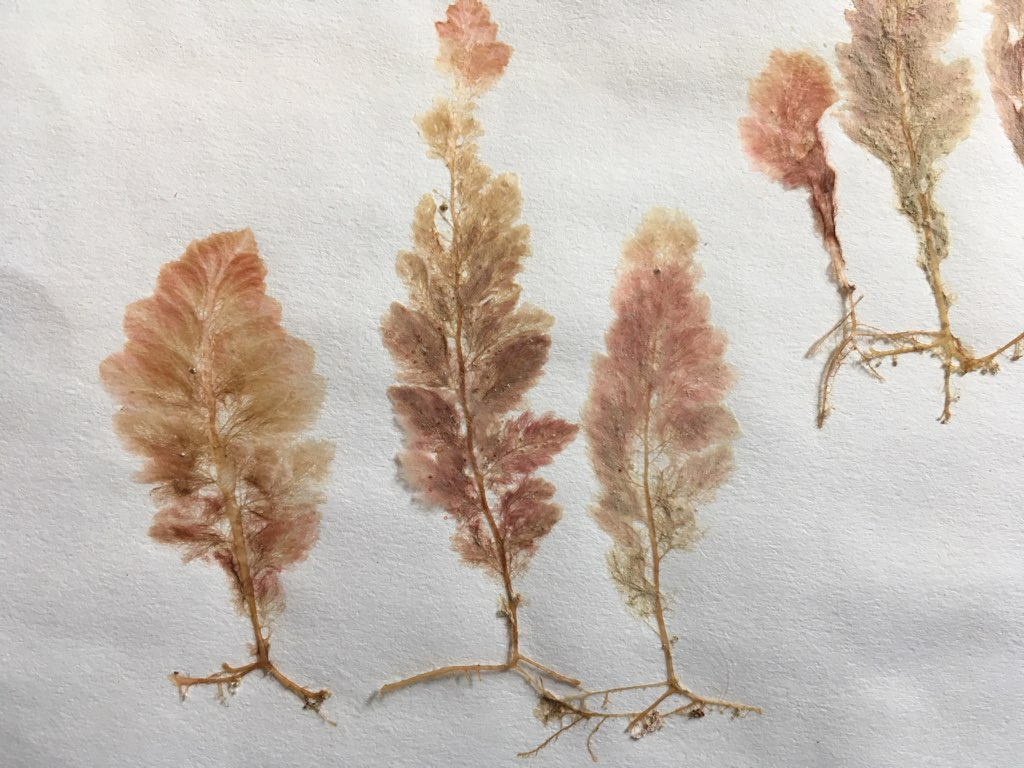
Before the Blue Fields offshore array becomes a reality, a series of land-based trials at our Kona research facility will establish which species may be best to grow, and what they need to thrive. In the coming months we will grow our limu with various mixes of deep seawater and surface seawater, and with different timed pulses of nutrients to determine the needs for scalable production. Our partners at Makai Ocean Engineering, are designing a wave-driven upwelling system to lift DSW nutrients to the offshore array. Once we have selected our target species, the team will finalize designs for a pilot-scale single-point mooring, long-line macroalgae array that harnesses wave, current and wind energy for nutrient delivery and harvesting. We also envisage testing a human-operated prototype algal harvester, with the long-term goal of it being a fully autonomous, reliable, high-yield cutting mechanism (think underwater ROV lawn mower). Through a competitive selection process, Blue Fields may eventually be deployed as a demonstration system offshore in West Hawaiʻi. The resulting biomass will be available for human consumption, as a source for feedstuffs for fish (see our nenue blog) or for cattle, and as material for testing as biofuels.
Seeded lines of Ulva.
We’re only just at the beginning. There’s a lot of work to be done and there is so much that’s still the subject of lively discussion. But that’s what research is about: asking, “What if?”. There is no single answer to all of our environmental challenges. However, seaweed offers a lot of potential to be a key player as we look for ways to feed humanity, mitigate ocean acidification and nutrient ‘dead zones’, and move towards alternative fuel sources.
Learn more about Research at Kampachi Farms.
References:
Bengston, S., Sallstedt, S., Whitehouse, M. (2017) Three-dimensional preservation of cellular and subcellular structures suggests 1.6 billion-year-old crown-group red algae. PLoS Biol., 15(3): e2000735. Available at: http://journals.plos.org/plosbiology/article?id=10.1371/journal.pbio.2000735 [Accessed June 18].
Shannon, E., Abu-Ghannam, N. (2016) Antibacterial derivatives of marine algae: an overview of pharmacological mechanisms and applications. Mar. Drugs., 14(81): doi: 10.3390/md14040081.Available at: https://arrow.dit.ie/cgi/viewcontent.cgi?article=1237&context=schfsehart [Accessed June 18].
Mohamed, S., Hasim, S.N., Rahman, H.A. (2012) Seaweeds: a sustainable functional food for complementary and alternative therapy. Trends Food Sci. Technol. 23(2), pp. 83–96.
The use of algae in fish feeds as alternatives to fishmeal (2013) The fish site [online] Available at: https://thefishsite.com/articles/the-use-of-algae-in-fish-feeds-as-alternatives-to-fishmeal [Accessed June 2018].
Bach, Q., Sillero M. S., Tran, K., Skjermo, J. (2014) Fast hydrothermal liquefaction of a Norwegian macro-alga: screening tests. Algal Res. 6(Part B), pp. 271-276.
How growing sea plants can help slow ocean acidification (2016) Yale Environment 360 [online] Available at: https://e360.yale.edu/features/kelp_seagrass_slow_ocean_acidification_netarts [Accessed June 2018].
Eco-friendly packaging concept made from seaweed wins Lexus Design Award 2016 (2016) De Zeen [online] Available at: https://www.dezeen.com/2016/04/19/eco-friendly-packaging-concept-agar-plasticity-seaweed-wins-lexus-design-award-milan-deisgn-week/ [Accessed June 2018].
Chopin, T., Sawhney, M. (2009) Seaweeds and their mariculture. Encyclopedia of Ocean Sciences (2nd Ed. ), pp. 317-326.
Single point mooring array for macroalgae (2018) ARPA-E Department of Energy [online] Available at: https://arpa-e.energy.gov/?q=slick-sheet-project/single-point-mooring-array-macroalgae [Accessed June 2018].
Huisman, J.M., Abbott, I.A., Smith, C.M. (2007) Hawaiian Reef Plants. University of Hawaiʻi Sea Grant College Program: Honolulu, HI.
Giant Groupers: ambassadors for reef conservation, flying to new homes across America.
Giant Pacific Grouper at our research facility in Kona, Hawaii. Photo Jeff Milisen
The Giant Grouper (Epinephelus lanceolatus) is possibly the rarest coral reef fish in the Pacific. This fish grows up to almost 1,000 lbs, but it has been so heavily over-fished throughout its native range (Hawaii, and the Indo-Pacific region), that it is now listed as “Vulnerable” (one step from “Endangered”) on the IUCN Red List[1]. The last reported sighting of this species from the Island of Hawaii was over 5 years ago.
Kampachi Farms – and our forebear, Kona Blue – have been rearing Giant Grouper at our Kona research facility since 1999. Because of the scarcity of these fish in local waters, we originally imported fingerlings from a hatchery in Taiwan, and grew them out until they started spawning … and they kept growing! Some of these fish are now over 18 years old, and weigh perhaps 300 pounds (But that’s just a guess … we don’t have any scales that can weigh fish this big!). And they are still growing!
Juvenile E. lanceolatus. Photo Jeff Milisen
The original intention was to try to raise these high-value groupers for commercial culture. However, this proved unfeasible for two reasons. Firstly, fish this big are very difficult to spawn. We have not obtained a viable spawn from these fish since 2012. We believe that the problem is that their tanks are too small, and they are not able to perform the courtship rituals that precede spawning. The second problem is that we were unable to wean the juveniles onto a more sustainable pellet diet. This meant that commercial culture of Giant Grouper would require a constant supply of sardines or squid to feed the fish, and that simply doesn’t work – either economically, or ecologically. We want our fish culture to soften humanity’s footprint on the seas, not to exacerbate it!
So – if not commercially valuable, we thought these fish might be valuable for conservation. We therefore requested permission from Hawaii state authorities to restock these fish onto Hawaii’s reefs, where divers could see them in their native habitat. However, some were concerned that these fish might be genetically distinct from the native Hawaiian population, and with no native fish to compare to our own, this proposal was scrapped.
So what to do? These fish have always been the “star of the show” for our research site tours and other outreach activities. They have served as fantastic ambassadors for reef conservation to the 6,500+ visitors who have toured the Kampachi Farms facility over the past few years. We have learned a lot from these beautiful fish, and their offspring, which were spawned and raised on-site by the research team. However, there comes a time when we have to say goodbye to those that we love … and it was that time for our Giant Groupers. But what to do with a 300 pound fish friend? The answer was to fly, not fry!









With the help of a very talented team of acquisition specialists at Reef and Ray, we are happy to announce that we have found new homes for our Giant Grouper. We have donated these fish to a number of aquariums throughout the United States, where they will be able to carry on their work as coral reef ambassadors, and live out their days in comfort, with other coral reef fish communities to keep them company. Over the past few weeks, twelve of our Giant Groupers have been sent to aquariums in Hawaii, Missouri, Indiana, and even as far as New Jersey. Our oldest and largest specimen (appropriately named “Hulk”), will be traveling to the Adventure Aquarium in Camden, New Jersey.
It has been a great joy and an honor to raise these magnificent fish. We wish them all long and enjoyable lives in their new homes! We’d also like to extend great thanks to all of the aquariums for adopting our Giant Grouper, where they will now connect with a broader audience – exemplifying the treasures of our precious ocean environment and our collective duty for preservation. Please stay tuned for updates as they arrive at their new aquariums. Follow our grouper updates on twitter @kampachifarms.
[1] The International Union for Conservation of Nature - assessment of the species Epinephelus lanceolatus - last assessment carried out in 2006 http://www.iucnredlist.org/details/7858/0
Why is There No Commercial Mahi-mahi Aquaculture Yet?
Mahimahi (Coryphaena hippurus), also known as Dorado or Dolphinfish, is a tropical oceanic predator. In the U.S., it is a prized sportfishing species with an annual recreational landing of approximately 5,000 tonnes in recent years; and it is in even higher demand commercially, leading the U.S. to import 25,000 tonnes in 2013 (1). Keep in mind these numbers are for the U.S. alone.
One of the reasons wild stocks have been able to endure this fishing pressure is the remarkable growth and reproductive capabilities of this species. Juveniles have been shown to gain roughly 30 grams a day in laboratory settings, and grow up to 9.5 kg in the first year (2,3). Perhaps more importantly, they reach sexual maturity in just 4 to 5 months in the wild and spawn up to 180 days of the year (4)!
The market, the growth rates, and the success in captive spawning are all there; so why is there no mahimahi aquaculture? The Achilles heel for C. hippurus thus far is their natural aggression: larval rearing can be challenging due to high rates of cannibalism at early life stages, followed by territorial bloodlust as they reach maturity. They start earning the moniker “dolphinfish” at a young age, exhibiting the ability to jump impressively high out of things (tanks) or into things (walls).
At Kampachi Farms we strive to allay this aggression by creating cohorts of single sex mahi. The sex of several other marine fish species can be determined by unique temperature fluctuations near time of spawning, and anecdotal evidence suggests this can be applied to mahi. By defining the ideal water temperature and timing/duration of exposure, we could provide a noninvasive, economical method of producing all-male cohorts. This would be ideal for aquaculture as male mahi aggression is naturally lower in the absence of females, and the overall growth rate of males is higher as they invest less energy in reproduction.
While mahi may be excellent restaurant fare, they are also incredibly useful for ecological research. The same biological features that make this a promising species for commercial production – exceptionally high metabolism, low age at reproduction – make a convenient proxy to illustrate the effects of environmental changes on marine finfish. The University of Miami has used their renowned C. hippurus spawning program in myriad studies since the Deepwater Horizon oil spill to observe the developmental effects this event may have had on pelagic fish species (spoiler: oil is not great for fish). Since mahi progress through their developmental stages so quickly, it is an ideal species in which to study toxicology. For instance, certain levels of embryonic exposure to crude oil may prove nonlethal, but may impact cardiac function and energy demands of the fish later in life (5,6). Similarly, mahi have been used to illustrate the metabolic and behavioral impacts of ocean acidification (7). This knowledge can be applied to past and future scenarios to better understand long term impacts of anthropogenic activity on fish population fitness.
Wild mahi have thus far proven robust to fishing pressure, but the world needs ever more seafood. Optimizing aquaculture of this species can increase availability, alleviate pressure on wild stocks, as well as provide invaluable knowledge for resource management in the face of a changing environment.
More mahi for all!
References:
- NMFS Recreational Fisheries Statistics Queries (2013). National Oceanic and Atmospheric Association. [online] Available at: https://www.st.nmfs.noaa.gov/st1/recreational/queries/ [Accessed 21 Nov. 2017].
- Hagood, R.W., Rothwell, G.N., Swafford, M., Tosaki, M. (1981) Preliminary report on the aquaculture development of the dolphin fish, Coryphaena hippurus (Linnaeus). J. WorldMaricult. Soc., 12(1), pp.135–139.
- Kraul, S. (1989) Review and current status of the aquaculture potential for the mahimahi, Coryphaena hippurus. Advances in Tropical Aquaculture, Workshop at Tahiti, French Polynesia, 20 Feb-4 Mar 1989.
- McBride, R.S., Snodgrass, D.J., Adams, D.H., Rider, S.J. and Colvocoresses, J.A. (2012) An indeterminate model to estimate egg production of the highly iteroparous and fecund fish, dolphinfish (Coryphaena hippurus). Bulletin of Marine Science, 88(2), pp.283-303.
- Esbaugh, A.J., Mager, E.M., Stieglitz, J.D., Hoenig, R., Brown, T.L., French, B.L., Linbo, T.L., Lay, C., Forth, H., Scholz, N.L. and Incardona, J.P. (2016) The effects of weathering and chemical dispersion on Deepwater Horizon crude oil toxicity to mahi-mahi (Coryphaena hippurus) early life stages. Science of the Total Environment, 543, pp.644-651.
- Pasparakis, C., Mager, E.M., Stieglitz, J.D., Benetti, D. and Grosell, M. (2016) Effects of Deepwater Horizon crude oil exposure, temperature and developmental stage on oxygen consumption of embryonic and larval mahi-mahi (Coryphaena hippurus). Aquatic Toxicology, 181, pp.113-123.
- Pimentel, M., Pegado, M., Repolho, T. and Rosa, R. (2014) Impact of ocean acidification in the metabolism and swimming behavior of the dolphinfish (Coryphaena hippurus) early larvae. Marine biology, 161(3), pp.725-729.
Velella Epsilon: Pioneering Offshore Aquaculture in the Gulf of Mexico
As part of a national initiative to increase U.S. aquaculture production in the next four years, Kampachi Farms has been awarded a grant in partnership with Florida Sea Grant to trial a new Velella net pen pilot project in the Gulf of Mexico.
Kampachi Farms has successfully deployed smaller Aquapod™ demonstration fish pens off the coast of Kona, Hawaii. The Velella Beta-test was awarded one of TIME Magazine’s 25 Best Inventions of the Year, and was featured on a National Geographic special hosted by Dr. Robert Ballard. The Velella Beta-test and the Velella Gamma project were both also highly popular with the local Kona fishing community, as the net pen arrays acted as Fish Aggregating Devices (FADs), and proved to be exciting dive sites for snorkel tours.
In 2016, NOAA Fisheries finalized a Rule that would allow commercial aquaculture operations to be permitted in U.S. federal waters in the Gulf. However, no applications have been received for such projects yet, according to Jess Beck-Stimpert, an aquaculture coordinator with NOAA Fisheries.
“This demonstration pen would therefore be the only permitted structure in Gulf waters,” said Beck-Stimpert.
One of the major barriers to commercially expanding open ocean aquaculture in the Gulf of Mexico has been its arduous permitting process.
Neil Anthony Sims, CEO for Kampachi Farms stated, “The primary goal of the demonstration project is to help the local communities in the Gulf of Mexico to understand the ancillary benefits that offshore aquaculture can bring to fisheries and to recreational tourism.”
Kampachi Farms also intends to start discussions with State and Federal agencies and the local community about pioneering an application for a commercial aquaculture permit in the Gulf of Mexico. The Velella Epsilon will use a SUBflex submersible net pen system (made by GiliOcean Technology), on a single-point mooring, which allows the net pens to pivot as the current direction changes. The project will also encourage recreational and charterboat fishermen to use the pen as a FAD, or Fish Aggregating Device. As part of the Sea Grant project, this process, and the community response, will be documented as a reference for future applicants.
Sims explained, “Once the Velella Epsilon has demonstrated the technology and benefits of offshore aquaculture to the local communities, then we will engage them in the discussions about how this industry might move forward. We will also work with the various agencies to identify areas needing further regulation or clarification of agency requirements, or areas where we could eliminate any redundancies. And, we will make our documentation on this process readily available for future aquaculture industry applicants to use as a template.”
For more information on previous Velella Project Trials see our Research Page.
Fertilized Kyphosus Eggs: moving culture of high-value herbivorous reef fish closer to reality
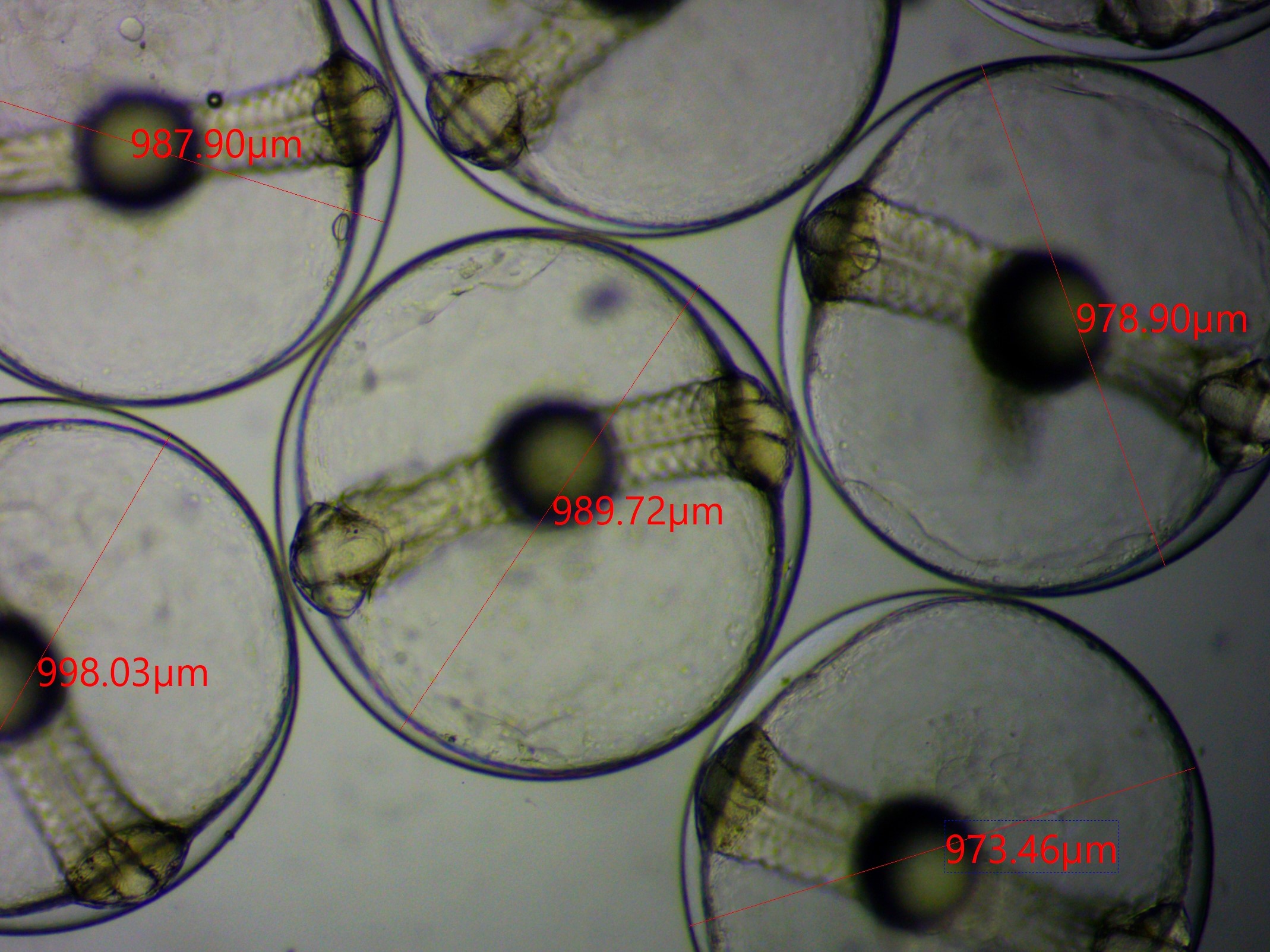

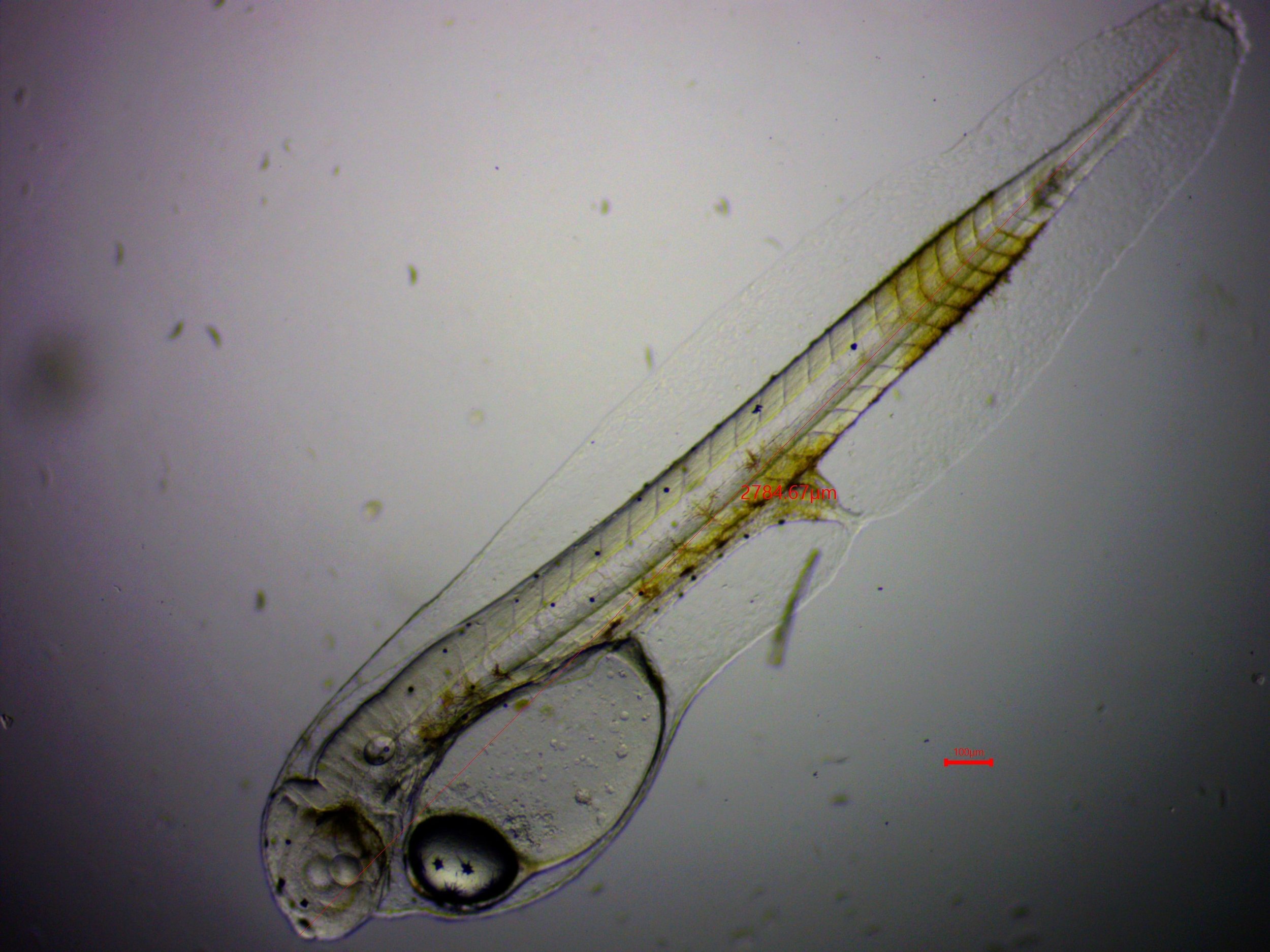
Kampachi Farms’ Research Team recently obtained fertilized eggs from our tank-reared nenue (rudderfish, Kyphosus vaigiensis). To our knowledge, this is the first captive-reared spawn ever obtained of any Kyphosidae family.
Kampachi Farms – along with many others in aquaculture research - have pursued enhanced sustainability by formulating "vegetarian" diets for carnivorous fish, such as our much-loved Cabo Kampachi™. However, few have focused on the potential for growing a high-quality herbivorous marine fish. Herbivorous fish are less widely appreciated, but in Hawaii a local reef herbivore, the nenue (rudderfish; a member of the Kyphosidae family), has always been prized as a food fish. These seaweed-grazers have a fantastically efficient ruminant-like gut, which allows them to digest and utilize macroalgae(seaweed, or ‘limu’, in Hawaiian). Cultured nenue could therefore potentially be grown on a highly sustainable and economical diet including macroalgae, agricultural byproducts and other plant-based materials. Perhaps most importantly, the fish tastes great and is very nutritious.
Learn more about our various research projects.
